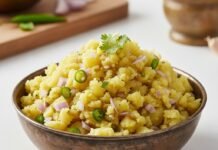Diwali—the festival of lights—symbolizes joy, prosperity, and togetherness. But let’s be honest: it also means an overload of sweets, fried snacks, and festive feasting. The good news? You don’t have to give up your favorite treats to stay healthy this Diwali. With the right tweaks, you can indulge guilt-free and still enjoy every bite of the celebration.
During the festive season, most of us tend to go overboard with sugary delights and deep-fried snacks. However, mindful eating doesn’t mean skipping the fun. It’s all about balance, smart ingredient swaps, and portion control. You can prepare desserts that are not only mouthwatering but also nourishing. Imagine enjoying a plate full of ladoos made with jaggery instead of sugar, or savoring crispy mathris baked to perfection rather than fried in oil.
Healthy sweets and snacks can bring the same joy to your Diwali platter while keeping your energy stable, immunity strong, and waistline happy. The trick lies in understanding your ingredients and making conscious choices. Let’s explore how you can keep the festive spirit alive—without the post-celebration guilt.
The Sugar Dilemma: How Traditional Sweets Affect Your Health
Traditional Indian sweets are undoubtedly delicious, but they often come loaded with refined sugar, ghee, and maida (refined flour). Consuming these in excess can lead to energy crashes, weight gain, and even affect your blood sugar levels. Refined sugar, in particular, offers empty calories—providing energy but no nutrients. When combined with deep-fried elements, the result is a recipe for fatigue and sluggishness.
Over the years, our bodies have become accustomed to these high-calorie indulgences, making it hard to resist during Diwali. Yet, being aware of what you’re eating can help you make better choices. Consider this: a single piece of gulab jamun can contain over 150 calories, and most of us don’t stop at one. Multiply that by the number of treats we sample in a day, and you’ll see how easily the calories add up.
Switching to healthier alternatives doesn’t mean giving up the taste of tradition. You can replace refined sugar with natural sweeteners like jaggery, honey, or dates. Instead of deep-frying, you can bake or air-fry to retain flavor without excess oil. These small changes can significantly reduce calorie intake while keeping your taste buds happy.
Smart Ingredient Swaps for Healthier Diwali Recipes
Creating healthier versions of Diwali treats starts with smart ingredient swaps. The goal is to preserve traditional flavors while improving nutritional value. Here are a few simple yet effective replacements you can make in your kitchen this festive season.
Natural Sweeteners: Honey, Jaggery, and Dates
Refined sugar is one of the main culprits behind unhealthy desserts. Replacing it with natural sweeteners not only adds depth of flavor but also boosts your nutrient intake. Jaggery is rich in iron and minerals, while dates offer fiber and antioxidants. Honey provides natural sweetness along with antimicrobial properties. When used mindfully, these alternatives can enhance both taste and health.
Nut Flours and Healthy Fats for Better Nutrition
Instead of using refined flour (maida), try almond flour, coconut flour, or whole wheat flour. These flours add more fiber and protein to your sweets, helping regulate blood sugar levels. Similarly, swap ghee or butter with healthier fats like cold-pressed coconut oil or olive oil. While traditional ghee has its own benefits, moderation is key.
The Role of Portion Control and Mindful Snacking
Even the healthiest treat can become unhealthy when consumed in excess. Portion control is crucial during Diwali. Serve your sweets on smaller plates and savor each bite slowly. This not only helps with digestion but also enhances your enjoyment of the food.
Guilt-Free Diwali Sweet Recipes
You don’t have to compromise on taste to eat healthy during Diwali. Here are some guilt-free sweet recipes that balance flavor and nutrition perfectly.
Almond and Dates Ladoo

These ladoos are naturally sweetened with dates and packed with nutrients from almonds. Simply blend pitted dates with roasted almonds, roll them into balls, and coat them with crushed nuts or desiccated coconut. They’re rich in fiber, good fats, and protein—making them a perfect festive snack.
Baked Coconut Barfi
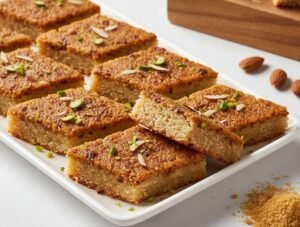
Traditional coconut barfi is usually made with sugar syrup and ghee. This baked version skips the sugar and uses honey or jaggery for sweetness. Mix grated coconut with almond flour, add honey, and bake until golden. The result? A chewy, fragrant barfi that’s light on calories and heavy on satisfaction.
Oats and Jaggery Halwa
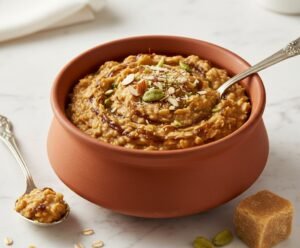
Halwa doesn’t have to be drenched in ghee and sugar. Use oats instead of semolina and sweeten it with jaggery. Add a handful of nuts for crunch and cardamom for aroma. This wholesome dessert offers complex carbs and fiber, keeping you fuller for longer.
Stevia-Sweetened Kheer
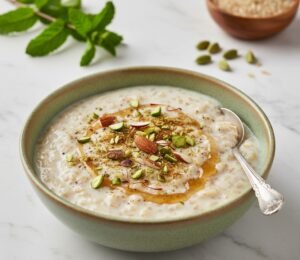
For those watching their sugar levels, Stevia is a great alternative. Make your kheer using low-fat milk, brown rice, and Stevia. Add chopped almonds and pistachios for a creamy, guilt-free treat that satisfies your sweet tooth without the sugar spike.
Savory Yet Healthy Festive Snacks
Who says Diwali is all about sweets? Savory snacks are just as important—and can be made healthy too.
Roasted Chivda Mix

Instead of deep-frying, roast flattened rice (poha) with peanuts, curry leaves, and spices. Use minimal oil and store in an airtight container. It’s light, crunchy, and perfect for snacking guilt-free.
Baked Mathri

A classic North Indian snack, mathris are traditionally fried. This baked version uses whole wheat flour, olive oil, and carom seeds. Bake until crisp for a healthier twist on an old favorite.
Air-Fried Namak Para
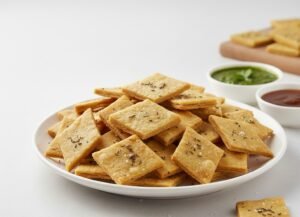
Air-frying gives the same crunch without the excess oil. Mix whole wheat flour with a bit of semolina, add seasoning, and air-fry until golden. You’ll love how deliciously crispy they turn out.
Hydration and Detox During the Festive Week
During Diwali, we often focus so much on feasting that we forget one of the most important aspects of health—hydration. Between the sweets, snacks, and long celebrations, your body can easily feel bloated, sluggish, or dehydrated. But the good news? You can balance out those indulgences with simple hydration and detox habits that cleanse your system naturally and restore energy.
Infused Water and Herbal Teas for Cleansing
Infused waters are an easy and flavorful way to stay hydrated. Add slices of lemon, cucumber, mint, and a few drops of honey to your water for a refreshing detox drink. The antioxidants from lemon and mint help flush out toxins, while cucumber adds hydration and cooling properties.
Similarly, herbal teas like green tea, chamomile, or tulsi (holy basil) tea are great for cleansing your system after heavy meals. Tulsi tea, in particular, supports digestion and helps balance blood sugar levels, which can spike after eating too many sweets.
Natural Detox Drinks Post-Feasting
Aloe vera juice, amla (Indian gooseberry) juice, or warm water with honey and lemon can be incredibly effective for morning detox. They aid digestion, improve skin glow, and enhance metabolism. Try starting your day with one of these before diving into festive activities—it’s a small step that makes a big difference.
To keep your energy up through the day, alternate between plain water, coconut water, and herbal drinks. The goal isn’t to “undo” indulgence but to support your body in processing festive foods efficiently.
The Art of Portion Control and Mindful Eating
Diwali is meant to be celebrated—not restricted. However, portion control is the secret to enjoying your favorite dishes without guilt. Mindful eating allows you to appreciate every flavor, stay connected with your body, and prevent overindulgence.
Tricks to Avoid Overindulging During Festivities
Start by using smaller plates or bowls. Studies show that smaller utensils subconsciously encourage you to eat less. Before reaching for a second helping, pause and check whether you’re truly hungry or just eating because everyone else is.
Avoid multitasking while eating—don’t snack while chatting, watching TV, or scrolling on your phone. When you eat mindfully, you chew slower, savor the taste, and naturally consume less.
Another great tip is to fill half your plate with lighter items like salads, roasted nuts, or grilled snacks before adding rich sweets or fried foods. This balances your meal and helps you feel satisfied faster.
Listening to Your Body’s Hunger Cues
Pay attention to what your body tells you. Diwali is about celebration, not stuffing yourself to the point of discomfort. Eat slowly and stop when you feel about 80% full. Remember—your stomach takes about 20 minutes to send fullness signals to your brain. That’s why pacing yourself matters.
Finally, don’t beat yourself up if you indulge a bit—it’s part of the celebration! Just balance it with healthy meals and activities the next day.
How to Include Superfoods in Your Diwali Menu
Superfoods are packed with nutrients and can easily elevate your Diwali recipes to a new level of health and taste. Adding them to traditional dishes doesn’t mean changing your favorite flavors—it’s about enhancing them.
Chia, Flaxseeds, and Nuts in Indian Sweets
Chia seeds, flaxseeds, and nuts can be mixed into ladoos, barfis, and halwas for extra crunch and nutrition. Chia and flaxseeds are rich in omega-3 fatty acids, which help keep your heart healthy and your energy levels high. You can even sprinkle them on top of sweets for a nutty texture.
Nuts like almonds, walnuts, and pistachios add healthy fats, protein, and fiber. They also give a rich, festive touch to your desserts while improving satiety. Instead of fried cashews, try dry-roasted ones for an equally satisfying bite.
Using Millets Instead of Refined Grains
Millets like ragi, bajra, and jowar are great alternatives to refined flours. They are gluten-free, high in fiber, and packed with minerals like calcium and magnesium. Replace refined flour in recipes like chakli, halwa, or cookies with millet flour for a more wholesome twist.
You can even make millet-based kheer or ladoos by combining them with jaggery and nuts—it’s a powerhouse of nutrition disguised as a treat.
Balancing Taste and Health for the Whole Family
The key to making healthy Diwali treats successful is ensuring that everyone enjoys them. Many people assume that “healthy” automatically means “tasteless,” but that’s far from the truth. You can prepare guilt-free treats that your kids, parents, and guests will love just as much as traditional ones.
Making Healthy Treats Kid-Friendly
Kids often crave colorful, sweet, and crunchy treats. Make energy balls with dates, oats, and cocoa powder instead of sugar-loaded candies. Add fun toppings like crushed nuts or coconut shavings. Smoothie bowls topped with fruits and granola can also serve as festive desserts.
If your little ones love halwa, try carrot halwa made with jaggery and low-fat milk—it’s sweet, creamy, and full of beta-carotene.
Getting the Family Involved in Healthier Cooking
Cooking together is a wonderful Diwali tradition. Involve your family in preparing these healthy dishes—it makes the celebration more meaningful and teaches kids about balanced eating. Assign fun roles: let the kids roll ladoos, while adults handle baking or air-frying.
This way, the focus shifts from overeating to creating memories, sharing laughter, and embracing a healthier lifestyle together.
Planning a Healthy Diwali Menu: A Step-by-Step Guide
Creating a festive yet nutritious menu doesn’t have to be overwhelming. With a bit of planning, you can enjoy a delightful spread that’s light on calories but rich in flavor.
Morning-to-Evening Festive Meal Plan
-
Morning: Start with warm water infused with lemon or cinnamon. Follow it up with a protein-rich breakfast like poha with vegetables or ragi pancakes.
-
Afternoon: Opt for balanced meals—grilled paneer, millet rotis, and vegetable curry. Avoid heavy fried foods.
-
Evening: Serve roasted snacks or baked mathris instead of deep-fried ones.
-
Dessert: End with a small portion of a healthy sweet like almond-date ladoo or oats halwa.
Smart Grocery List for Guilt-Free Cooking
-
Jaggery, honey, or dates (natural sweeteners)
-
Almond flour, coconut flour, and whole wheat flour
-
Millets like ragi, jowar, and bajra
-
Cold-pressed oils and ghee (for moderation)
-
Superfoods: chia seeds, flaxseeds, and assorted nuts
-
Herbal teas and detox ingredients like mint, lemon, and tulsi
This simple plan ensures you’re equipped for a balanced and health-conscious Diwali feast without compromising on traditional flavors.
The Emotional Side of Festive Eating
Food and emotions are deeply intertwined, especially during festivals like Diwali. Every bite carries memories—of family gatherings, laughter, and the aroma of home-cooked delicacies that fill the air. However, this emotional connection can sometimes lead to overeating or guilt afterward. The key lies in embracing festive food with mindfulness and gratitude instead of restriction or remorse.
How Food Connects Us During Diwali
Diwali isn’t just about the lights—it’s about the love shared over meals. The act of preparing sweets and snacks together creates bonds that are as nourishing as the food itself. Offering sweets to guests, exchanging homemade delicacies, and sitting together for festive feasts are cultural rituals that symbolize abundance and affection.
When you cook or eat with intention, you reconnect with the true meaning of Diwali—celebrating joy, generosity, and connection. Savoring your food mindfully allows you to appreciate not only the flavors but also the memories and effort behind each dish.
Replacing Guilt with Gratitude and Balance
Instead of feeling guilty for indulging in sweets, practice gratitude for the abundance that allows you to celebrate. It’s okay to enjoy that extra piece of barfi as long as you do it consciously. Balance indulgence by making lighter choices for your next meal or going for an evening walk after a big feast.
When you view food as a celebration rather than a temptation, you shift from guilt to joy. Remember, true health is about harmony—nourishing your body and your soul simultaneously.
Long-Term Benefits of Choosing Healthier Festive Foods
Adopting a healthier approach to Diwali eating isn’t just about surviving the festive week—it’s about setting the foundation for lasting well-being. Making small, consistent changes during the festival can lead to long-term health benefits that extend far beyond Diwali.
Sustaining Energy and Immunity Post-Diwali
Ever felt sluggish after days of festive indulgence? Heavy foods high in sugar and oil can drain your energy and weaken your immunity. On the other hand, nutrient-rich ingredients like nuts, seeds, and whole grains provide sustained energy and strengthen your immune system.
By swapping refined ingredients for natural ones, you ensure your body gets a steady supply of vitamins, minerals, and antioxidants. You’ll notice improved digestion, better sleep, and more stable moods even after the festivities end.
Building Healthy Habits Through Traditions
When you make healthy choices part of your Diwali tradition, they naturally carry forward year after year. Teaching children to enjoy homemade, wholesome sweets instead of store-bought ones can shape their food habits for life. Similarly, choosing baked over fried snacks or jaggery over sugar gradually becomes second nature.
Health-conscious traditions not only benefit you but also inspire others in your family and community to follow suit. Over time, Diwali becomes not just a festival of light—but also of health, harmony, and mindful living.
Expert Tips for Hosting a Healthy Diwali Party
If you’re hosting this year’s Diwali get-together, you can easily make it both festive and healthy. All it takes is creativity, presentation, and a few smart choices.
Creative Serving Ideas for Healthy Dishes
Presentation plays a huge role in how food is perceived. Arrange your snacks and sweets beautifully using colorful platters, banana leaves, or mini dessert cups. Serve bite-sized portions of sweets like mini barfis or mini kheer shots. Smaller servings look elegant and help guests indulge without overeating.
You can also set up a DIY snack bar with roasted nuts, air-fried namak paras, and healthy dips like hummus or yogurt chutney. Guests will love the variety—and you’ll keep the calorie count under control.
Balancing Indulgence with Wellness Choices
Balance is the theme of a successful Diwali spread. Pair rich dishes with light ones—for instance, serve baked mathris with a tangy salad or roasted chivda with a glass of buttermilk. Include refreshing drinks like lemon-mint cooler, coconut water, or herbal tea instead of sugary sodas.
Another fun idea is to include an activity break—play traditional games like antakshari or cards between courses. It keeps everyone active and prevents post-meal lethargy. Hosting a “healthy Diwali” doesn’t mean less enjoyment—it means more energy, laughter, and mindful indulgence.
Conclusion: Celebrate Light, Not Calories
Diwali is a time to celebrate light, happiness, and togetherness—not calorie counting. With a few mindful changes, you can enjoy every sweet, every flavor, and every moment without the guilt. Healthy Diwali treats are not about deprivation—they’re about rediscovering how vibrant and nourishing traditional Indian cuisine can be when made with love and intention.
By choosing natural sweeteners, incorporating superfoods, and cooking with wholesome ingredients, you not only take care of your health but also honor the true spirit of Diwali—spreading light and well-being in every home. So this festive season, celebrate consciously, eat joyfully, and let your glow come from within as much as from the diyas around you.
FAQs
1. Can I make Diwali sweets without refined sugar?
Absolutely! Replace refined sugar with jaggery, honey, or dates. These natural sweeteners enhance flavor while offering minerals and antioxidants that refined sugar lacks.
2. What are the best flours for healthy Indian desserts?
Whole wheat, almond, coconut, and millet flours are excellent alternatives to refined flour (maida). They add fiber and nutrients without compromising taste.
3. How can I control my portion size during Diwali?
Use smaller plates, eat slowly, and savor each bite. Balance heavier sweets with lighter meals and drink plenty of water to stay full longer.
4. Are there vegan options for traditional Diwali treats?
Yes! You can use coconut oil or almond milk instead of ghee and dairy milk. Many traditional sweets like coconut barfi and date laddoos are naturally vegan-friendly.
5. How do I balance festive eating with my fitness goals?
Plan ahead—exercise in the morning, eat balanced meals, and allow small indulgences mindfully. Staying active and hydrated helps you enjoy Diwali guilt-free.



